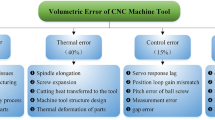Abstract
This work presents a novel cutting-path planning strategy for three-axis machining of 3D scanning data. A curve-fitting algorithm is employed to fit each array of the measured data into parallel sectional curves, ensuring that the effect of measurement and form errors can be substantially reduced. The best-fitting sectional curves are then used to construct a surface of triangular meshes. A modified chord-length method is also proposed to adequately control the accuracy of the triangular meshes generated. The triangular meshes are then offset along the surface normal to obtain an offset mesh surface on which the cutting paths are planned. An effective gouging detection and removal algorithm are also proposed to prevent the machined surface from overcutting. Several computer simulation results demonstrate the feasibility of the proposed strategy.
Similar content being viewed by others
References
J. Bobrow, “NC machine tool path generation from CSG part representations”,Computer-Aided Design,17(2), pp. 439–444, 1985.
G. Loney and T. Ozsoy, “NC machining of free-form surfaces”,Computer-Aided Design,19(2), pp. 85–90, 1987.
B. Choi, C. Lee, J. Hwang and C. Jun, “Compound surface modeling and machining”,Computer-Aided Design,20(3), pp. 127–136, 1988.
G. Catania, “A computer-aided prototype system for NC rough milling of free-form shaped mechanical part-pieces”,Computers in Industry,20, pp. 275–293, 1992.
Y. D. Chen, J. Ni and S. M. Wu, “Real-time CNC tool path generation for machining IGES surfaces”,ASME Journal of Engineering for Industry,115, pp. 480–486, 1993.
J. Y. Lai and D. J. Wang, “A strategy for finish cutting path generation of compound surfaces”,Computers in Industry,25(2), pp. 189–209, 1994.
K. I. Kim and K. Kim, “A new machine strategy for sculptured surface using offset surface”,International Journal of Production Research,33(6), pp. 1683–1697, 1995.
C. Bradley and G. W. Vickers, “Automated rapid prototyping utilizing laser scanning and free-form machining”,Annals of the CIRP,41, pp. 437–440, 1992.
A. C. Lee, D. P. Chen and C. L. Lin, “A CAD/CAM system from 3D coordinate measuring data”,International Journal of Production Research,28(12), pp. 2353–2371, 1990.
S. Kawabe, F. Kimura and T. Sata, “Generation of NC commands for sculptured surface machining from 3-coordinate measured data”,Annals of the CIRP,29(1), pp. 369–372, 1980.
B. Sarkar and C. H. Menq, “Parameter optimization in approximation curves and surfaces to measurement data”,Computer Aided Geometric Design,8, pp. 267–290, 1991.
B. Sarkar and C. H. Menq, “Smooth-surface approximation and reverse engineering”,Computer-Aided Design,23(9), pp. 623–628, 1991.
C. Bradley and G. W. Vickers, “Free-form surface reconstruction for machine vision raid prototyping”,Optical Engineering,32(9), pp. 2191–2200, 1993.
G. T. Dobson, W. N. Waggenspack and H. J. Lamousin, “Feature based models for anatomical data fitting”,Computer-Aided Design,27(2), pp. 139–146, 1995.
W. Ma and J. P. Kruth, “Parameterization of randomly measured points for least squares fitting of B-spline curves and surfaces”,Computer-Aided Design,27(9), pp. 663–675, 1993.
L. Fang and D. C. Gossard, “Multidimensional curve fitting to unorganized data points by nonlinear minimization”,Computer-Aided Design,27(1), pp. 48–58, 1995.
T. Kondo, T. Kishinami and K. Saito, “Machining system based on inverse offset method”,Japan Society of Precision Engineering (in Japanese),54(5), pp. 167–172, 1988.
T. Kondo, T. Kishinami and K. Saito, “Machining system based on scanning data”,Japan Society of Precision Engineering (in Japanese),54(6), pp. 62–67, 1988.
D. F. Rogers and J. A. Adams,Mathematical Elements for Computer Graphics, McGraw-Hill, 1990.
J. Y. Lai and C. Y. Lu, “Reverse engineering of composite sculptured surfaces”,The International Journal of Advanced Manufacturing Technology,12, pp. 180–189, 1996.
Author information
Authors and Affiliations
Rights and permissions
About this article
Cite this article
Lin, CY., Hwang, YY. & Lai, JY. Interference-free cutting-path generation based on scanning data. Int J Adv Manuf Technol 13, 535–547 (1997). https://doi.org/10.1007/BF01176297
Issue Date:
DOI: https://doi.org/10.1007/BF01176297




